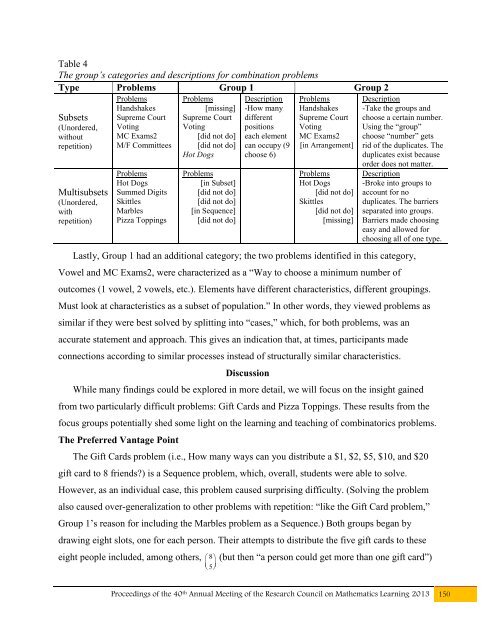2013 Conference Proceedings - University of Nevada, Las Vegas
2013 Conference Proceedings - University of Nevada, Las Vegas
2013 Conference Proceedings - University of Nevada, Las Vegas
- No tags were found...
You also want an ePaper? Increase the reach of your titles
YUMPU automatically turns print PDFs into web optimized ePapers that Google loves.
Table 4The group’s categories and descriptions for combination problemsType Problems Group 1 Group 2Subsets(Unordered,withoutrepetition)Multisubsets(Unordered,withrepetition)ProblemsHandshakesSupreme CourtVotingMC Exams2M/F CommitteesProblemsHot DogsSummed DigitsSkittlesMarblesPizza ToppingsProblems[missing]Supreme CourtVoting[did not do][did not do]Hot DogsProblems[in Subset][did not do][did not do][in Sequence][did not do]Description-How manydifferentpositionseach elementcan occupy (9choose 6)ProblemsHandshakesSupreme CourtVotingMC Exams2[in Arrangement]ProblemsHot Dogs[did not do]Skittles[did not do][missing]Description-Take the groups andchoose a certain number.Using the “group”choose “number” getsrid <strong>of</strong> the duplicates. Theduplicates exist becauseorder does not matter.Description-Broke into groups toaccount for noduplicates. The barriersseparated into groups.Barriers made choosingeasy and allowed forchoosing all <strong>of</strong> one type.<strong>Las</strong>tly, Group 1 had an additional category; the two problems identified in this category,Vowel and MC Exams2, were characterized as a “Way to choose a minimum number <strong>of</strong>outcomes (1 vowel, 2 vowels, etc.). Elements have different characteristics, different groupings.Must look at characteristics as a subset <strong>of</strong> population.” In other words, they viewed problems assimilar if they were best solved by splitting into “cases,” which, for both problems, was anaccurate statement and approach. This gives an indication that, at times, participants madeconnections according to similar processes instead <strong>of</strong> structurally similar characteristics.DiscussionWhile many findings could be explored in more detail, we will focus on the insight gainedfrom two particularly difficult problems: Gift Cards and Pizza Toppings. These results from thefocus groups potentially shed some light on the learning and teaching <strong>of</strong> combinatorics problems.The Preferred Vantage PointThe Gift Cards problem (i.e., How many ways can you distribute a $1, $2, $5, $10, and $20gift card to 8 friends?) is a Sequence problem, which, overall, students were able to solve.However, as an individual case, this problem caused surprising difficulty. (Solving the problemalso caused over-generalization to other problems with repetition: “like the Gift Card problem,”Group 1’s reason for including the Marbles problem as a Sequence.) Both groups began bydrawing eight slots, one for each person. Their attempts to distribute the five gift cards to theseeight people included, among others, æ 8 (but then “a person could get more than one gift card”)öçè 5÷ ø<strong>Proceedings</strong> <strong>of</strong> the 40 th Annual Meeting <strong>of</strong> the Research Council on Mathematics Learning <strong>2013</strong> 150




